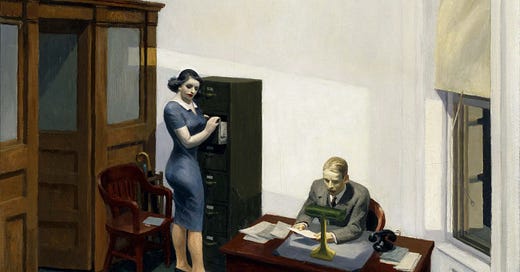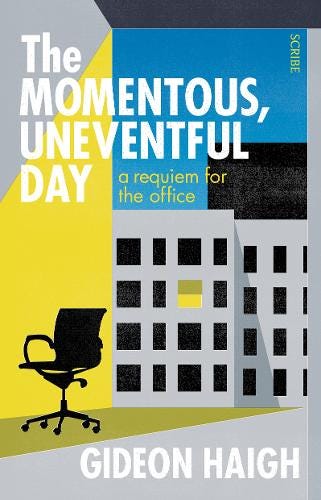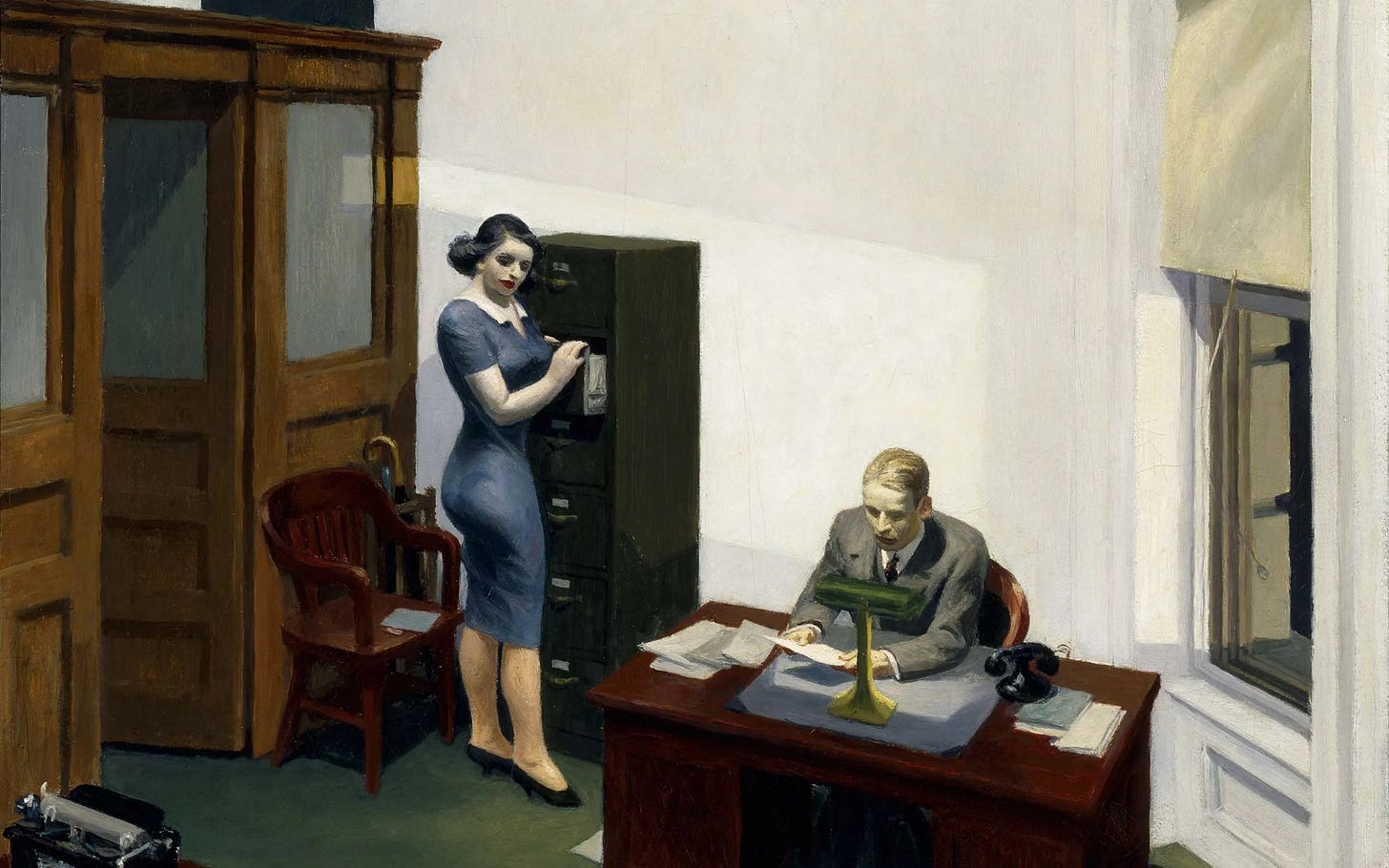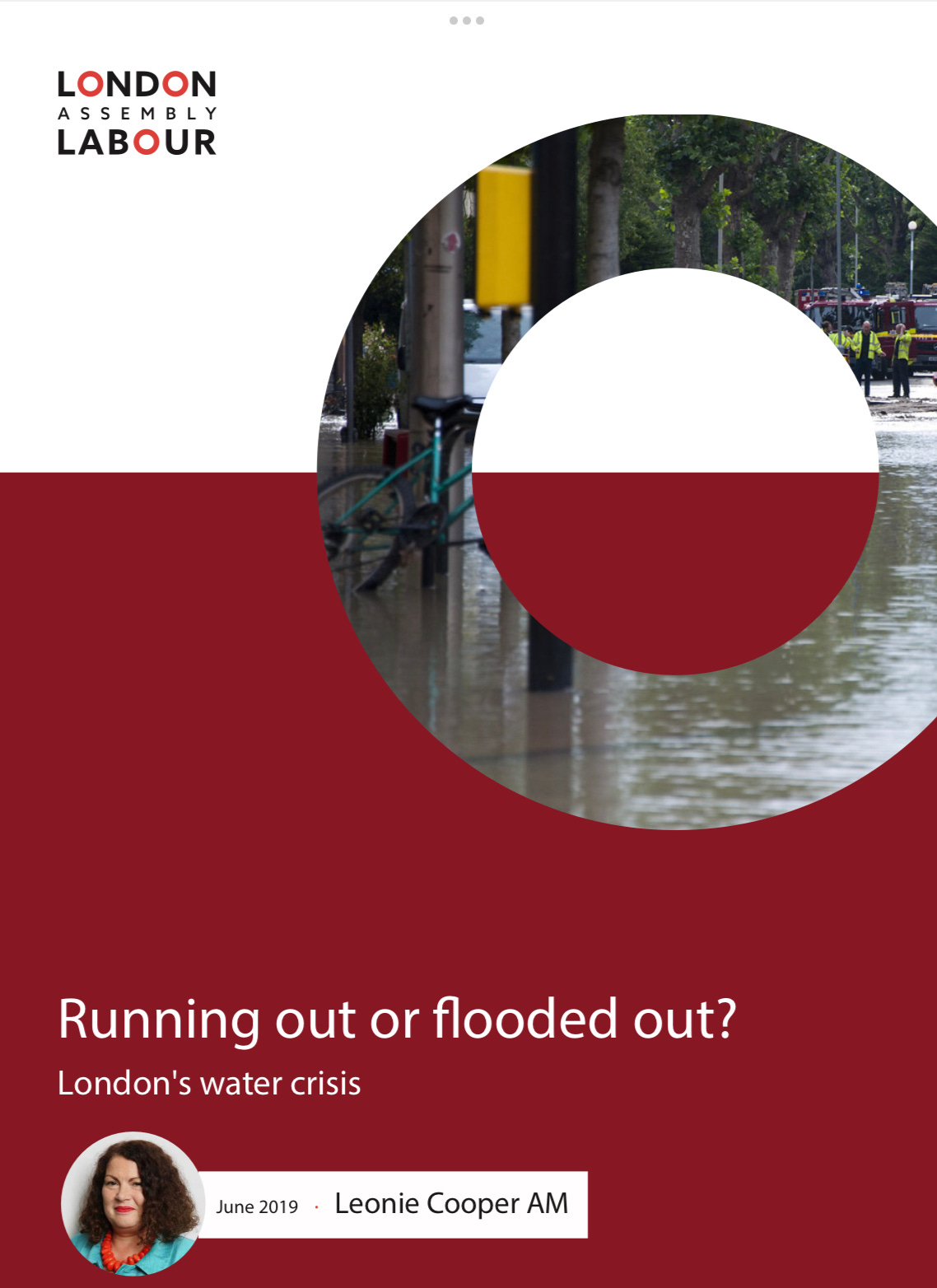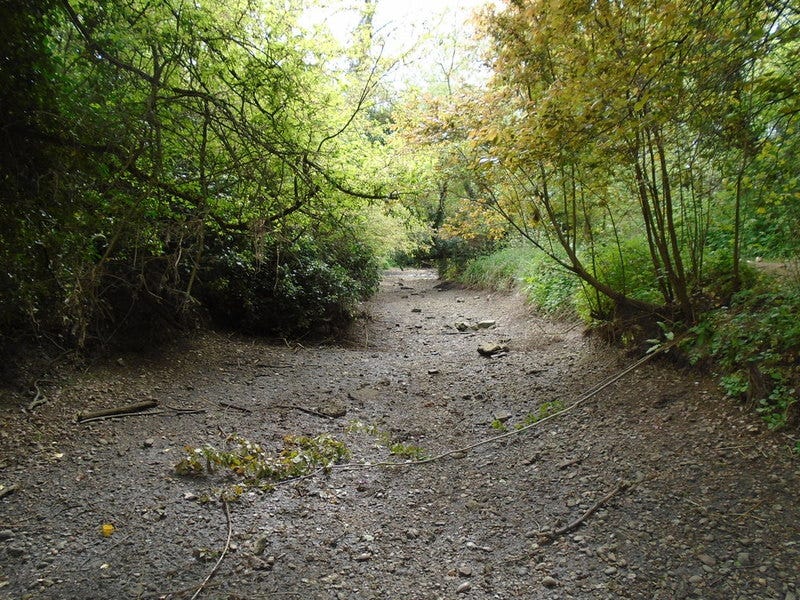15 August 2022. Offices | Water
The history of the office: gender and control. // Running out of water
Welcome to Just Two Things, which I try to publish daily, five days a week. Some links may also appear on my blog from time to time. Links to the main articles are in cross-heads as well as the story. A reminder that if you don’t see Just Two Things in your inbox, it might have been routed to your spam filter.
1: The history of the office is a history of gender and control
This is Part 1 of a two-part review of Gideon Haigh’s The Momentous, Eventful Day, a two hundred year history of the office. Part 2 tomorrow.
Gideon Haigh is the best known for his outstanding writing on cricket, but he also has a sideline in writing about business. He brings the same eye to this—informed, always slightly sceptical—as he does to his cricket books. And, as with his cricket coverage, he wears his learning lightly.
I missed his book The Office from the early 2010s, so I was pleased to stumble on his more recent book on the same subject, The Momentous, Eventful Day which charts a 200-year history of the office, mostly in the Anglo-Saxon world.
The title is from a novel by William Howells, published in 1885. And this is really the first clue to this short and readable book: it is, first and foremost, a cultural history of the office. Architects and designers get their share of the story but so do novelists, artists, and filmmakers.
The book was prompted by the pandemic, and I’ll come back to that, but in many ways the early history of the office is more intriguing. Most of the elements we see in the modern office are also seen in its 19th century origins.
It is a history of gender and control, as much as it is a history of economics and technology.
The office worker starts to appear in literature from the 1840s onwards, for example in The Christmas Carol and Great Expectations, as capitalism starts to become more complicated. The notion that this was, somehow, not real work followed along quickly enough. Haigh quotes the 1907 book, Robert Thorne: the story of a London clerk, in which one of the characters asks:
(D)on’t we lose our manhood? What do we see of real life? What do we know if the world? We are a small breed. We aren’t real men (p. 21).
The arrival of the mechanical typewriter brought women into the office (both women and machines were known as "typewriters").
Haigh is clear-eyed about why this happened: women were much cheaper to hire than men. But this brought endless complications in a world where gender relationships were otherwise tightly controlled.
Bosses created different male and female entrances, staggered male and female starting times, and cordoned off work and luncheon areas... But such gestures at segregation crumbled before the necessities of efficiency. To get work done effectively, men and women simply had to occupy the same spaces (p.29)
One of the effects of this was to recreate in the office the rhythms and routines of the home. Secretaries became the ‘consort’ and the ‘ally’ of the boss. The odious phrase ‘office wife’ was the title of a 1930s novel. In this context, Haigh references Edward Hopper’s 1940 painting, ‘Office at Night’:
A tight dress hugs the secretary’s curves, while in alabaster pallor stresses a boss’s chaste self-mastery, as a single piece of paper falls between them. A door and a filing cabinet are open a little... The frisson is palpable (p. 32).
(Edward Hopper, ‘Office at Night’, 1940)
Yet women are almost effaced from stories about the office in the 1950s.
William Whyte’s book, Organisation Man, doesn’t have much space for organisation women, and the business women who appear in the films of the 1950s end up lonely or domesticated. Betty Friedan’s pioneering 1963 book The Feminine Mystique addressed this issue specifically:
In almost every professional field, business and in the arts and sciences, women are still treated as second-class citizens. It would be a great service to tell girls who planned to work in society to expect this subtle, uncomfortable and discrimination – tell them not to be quiet, and hope it will go away, but fight it (p.50).
But the biggest selling books of the time on women and work, by Helen Gurley Brown, suggested that women should use
your sex appeal and femininity to get ahead on a job.
As with the factory, the office had also been the subject of experiments in Taylorist ‘scientific management’, but it didn’t really stick. Office work is harder to measure and manage. Mayo’s ‘human relations’ school emerged in the factory as a response to Taylorism, and it was only a matter of time before it also migrated to the office.
Haigh is sceptical of both Mayo’s research and of the motives of the ‘human relations’ school.
On the first, it seems that the research was designed in such a way that “the experimenters saw what they wished to see”. On the second, they changed little of the underlying power structures of the office:
The differences between the alternative schools of management were more of form than content. They were hierarchical, invested in the executives wisdom and benevolence, and in the workers’ infantilised need to be led; they had the same ends, and sought the same docility (p.36).
Haigh notes that the most popular of the ‘human relations’ manifestoes—Chester Barnard’s Functions of the Executive—managed to talk about respect and fairness in one breath, and recommended all kinds of exclusion, or exclusiveness, on grounds of ‘fit’, in the next.
Haigh’s assessment of the human relations school is that it foreshadows the modern human relations department:
all those cloying rituals of bonding, motivation, and morale boosting, all those vague vacuities in mission statements about companies ‘putting people first’ that are essentially the substitution of manipulation for authoritarianism (p.37).
There’s a short interview with Gideon Haigh (18 minutes) by Danae Gibson about the book on RTR radio.
2: Running out of water
There’s a short piece on the On London website prompted by the current drought in the south of England on the possibility of London running out of water. Not yet, it seems, but possibly by the middle of the century:
In a speech in February (James Bevan, chief executive of the Environment Agency) said the whole of England could soon approach “the jaws of death”, by which he meant “the point on water companies’ planning charts some 20 years from now when, if we don’t intervene, the demand for water in this country will outstrip supply.” Climate change “will make water supply more erratic and cause more droughts,” he warned, while population growth will push up demand.
The London Assembly Labour Party AM Leonie Cooper has also produced a report on the subject in 2019, called ‘Running Out or Flooded Out?’, which looked at the two ends of the water problem.
She was keen to see the building of a proposed reservoir near Abingdon, about 50 miles to the west of the city. There’s a couple of things we might want to do first: London’s water consumption per head is slightly above the national average, at 149 litres per person per day, so saving on some of that would be a good idea. And a quarter of London’s water leaks out through the pipes, so Thames Water might be encouraged to increase their recently announced and somewhat belated investment to address this, rather than funnelling money to their shareholders.
All of this reminds me of some futures work I did around 15 years ago to inform England’s national water strategy. One of our scenarios did have a story about long-run water shortage in London. It wasn’t hard to get to this: even then, London was more water stressed than Istanbul, and none of the climate change projections looked like they’d improve things. And in that 2050 scenario, we did end up building a reservoir, though not near Abingdon.
There’s a sequel to this story. A few years later, I ended up doing some shorter-run scenarios on water to inform some strategy decisions for an organisation that worked in the sector. (I need to be a little vague here).
Early on, I was wheeled in to see the senior person in the organisation, who was the high level sponsor of the work. He’d been involved in Britain’s water system since the very first days of its privatisation. He looked me up and down:
You’re the person who wrote the scenario about turning Heathrow into a reservoir. I don’t want any of that implausible nonsense in these scenarios.
I demurred that those were 2050s scenarios, not ten-year scenarios, and that this was one scenario in a set of four, before being ushered out.
(River in drought, by John Webb, via Geograph.org. CC BY-SA 2.0)
I didn’t say that the idea of turning Heathrow into a reservoir had come, during our research, from a water engineer who had been involved in assessing what London should do if it started running out of water. As it happens, using Heathrow makes quite a lot of sense. It has a single owner, the geology is good, and it is close to the rest of the reservoir network to the immediate west of the city.
Of course, for whatever reason, Heathrow maintains a magical place in the imaginaries of British politicians and policy-makers, so it’s hard to persuade them that if it really came to a choice between water and planes, in a world where we would likely be flying a good deal less, we’d probably choose water and scrap an airport. If only for public health reasons.
But: it was also a salutary lesson in the use of the word “plausible” in a futures discussion. Joseph Voros uses it to mean a future that we can imagine, but isn’t yet technically or scientifically feasible (a world powered by nuclear fusion, for example.)
Of course, turning Heathrow into a reservoir wasn’t ‘plausible’ in a set of ten-year scenarios. The necessary conditions wouldn’t have materialised in that timeframe. But my senior executive didn’t mean that. What he meant was that he was unable to imagine a world where the freedom of the affluent to travel the world on a whim came second to making sure that everyone had enough water.
Notes from readers: music
It seems that I made a small mistake in my piece on Vaughan Williams and Holst on Friday, and I’m grateful to Ian Callow for putting me right. The event that led to the BBC taking over the Proms in 1927 was not the death of Henry Wood—who carried on conducting them until his actual death in 1944—but a decision by Chappell’s, the music publisher, to stop funding them because of their lack of profitability. Wood welcomed the BBC, which gave greater artistic and programming freedom.
The interest of the two composers in folk music was part of a wider trend, as Ian notes:
Holst and Vaughan Williams (and Cecil Sharp) can also be seen in a broader European context. For example, similar expeditions were being conducted by Bartok and Kodaly in central Europe before the Great War. The irony is that the use of new technology (a ‘benefit’ of industrialisation) was combined with a desire to preserve folksong associated with an agricultural economy that the collectors feared would otherwise be lost.
j2t#361
If you are enjoying Just Two Things, please do send it on to a friend or colleague.
